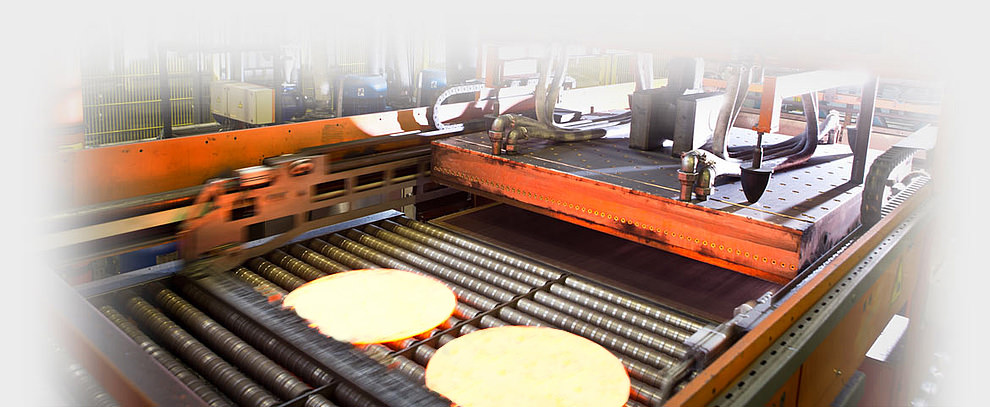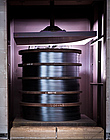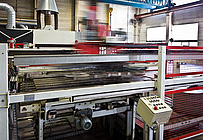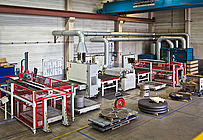Hardening and Tempering
The hardening and tempering is carried out for the improvement of the technological characteristic variables (yield strength, resistance, toughness) of a building component. Tempering and hardening is done in two steps:
1. The hardening
2. The subsequent tempering
The hardenability of steel is due to the fact that above 911°C the modification of the iron changes. The body-centered cubic lattice, known in metallographic terms as “ferrite”, will, through reorientation of the iron atoms, become the face-centered cubic lattices, the “austenite” and the carbides dissolve. As the C content increases the transformation temperature is reduced to a minimum of 0.8% C at 723°C.
In contrast to the ferrite, which in practice cannot dissolve carbon, the austenite is able to do this. It then creates a so-called solid solution of Fe and C. When the austenite is so quickly cooled that the diffusion of carbon from the unit cell is prevented, then there arises a hard structure, the "martensite".
It arises due to trapped carbon greatly distorting the ferrite. This leads to very high internal stresses in the martensite itself. The hardenability of steels is greatly influenced by alloying elements. These occupy lattice sites of iron atoms and act practically as "impurities". Since they do not participate in the transformation processes of the iron, these elements slow down the hardening process.
Such steels can therefore be cooled slower and one achieves considerably deeper hardening depths. In addition, the conversion characteristic changes greatly. This ideally leads to the situation that the otherwise typical ferrite pearlite is omitted or is significantly delayed.
This leads to the formation of the hardness structure, the martensite and / or "bainite". In bainite there is found, distorted ferrite as well as ferrite with very fine carbide precipitation. The old name for the bainite was "intermediate stage". This name very well characterizes this structural state.
Tempering: The hardening process results in significant residual stresses in the steel and hence to a critical decrease in toughness. After the hardening the process to improve the toughness properties begins to ensure the workability and formability of the components.
This is done in a temperature range below the transition temperatures of steel, in general between 200-700°C depending on the steel quality and requirements. Basically, the higher the tempering temperature, the lower the residual hardness and increasing toughness properties. Few high-alloy tool steels show a so-called secondary hardness maximum. With such steels there occurs at higher tempering temperatures the precipitation processes allowing a renewed increase in hardness.
Härterei Carl Gommann GmbH
Dreiangelstraße 29
42855 Remscheid
Germany
Tel.: +49 (0) 2191 8865-0
Contact form >>
Drop-off and Pick-up Times
Monday, Tuesday, Thursday, and Friday:
7:00 AM – 6:00 PM
Wednesday:
7:00 AM – 3:30 PM





Heat Treating / Gas Nitriding / Hardness Testing
The largest equipments available:
- Ø 350-3500 mm (smaller diameters on request) max. thickness 15 mm, max. weight per piece 750,- kg
- up to Ø 1,500 mm there is a dry curing possible, over and above this an oil hardening the max. treatable thickness of the sheets is dependent on the material.
For all processes a great number of smaller equipment is available.



